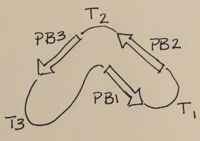Polygalacturonase
From Proteopedia
(Difference between revisions)
| Line 20: | Line 20: | ||
A right-handed parallel beta helix is a tertiary fold. The secondary structure is the beta and the alpha structure. If you describe how the secondary structure folds in space, that becomes tertiary structure. The secondary structural elements of the core fold of the proteins are only beta structure, the beta strands form parallel beta sheets. There are three main parallel beta sheets, PG's often have a smaller parallel beta sheet of only three-four beta strands. Nomenclature on how the sheets and turns are labeled are described in Yoder et al<ref name="yoder">PMID:8081738</ref>. | A right-handed parallel beta helix is a tertiary fold. The secondary structure is the beta and the alpha structure. If you describe how the secondary structure folds in space, that becomes tertiary structure. The secondary structural elements of the core fold of the proteins are only beta structure, the beta strands form parallel beta sheets. There are three main parallel beta sheets, PG's often have a smaller parallel beta sheet of only three-four beta strands. Nomenclature on how the sheets and turns are labeled are described in Yoder et al<ref name="yoder">PMID:8081738</ref>. | ||
| - | Not all PGs have ten coils in the parallel beta helix. They usually have approximately 10 coils. [[Image:PBH2.jpg|200px|left|thumb| Nomenclature for structural elements of the parallel beta helix<ref name="yoder" />. PB1 is Parallel Beta Sheet 1, T1 is Turn 1, between PB1 and PB2., | + | Not all PGs have ten coils in the parallel beta helix. They usually have approximately 10 coils. [[Image:PBH2.jpg|200px|left|thumb| Nomenclature for structural elements of the parallel beta helix<ref name="yoder" />. PB1 is Parallel Beta Sheet 1, T1 is Turn 1, between PB1 and PB2., PB3]] With the parallel beta helix fold, the three major beta sheets are call PB1, PB2, and PB3. The turns between strands are Turn 1 (T1) between PB1 and PB2, T2 is the turn between PB2 and PB3, and T3 is the turn between PB3 and PB1 of the next coil. For your reference, this is illustrated in the figure below. |
</StructureSection> | </StructureSection> | ||
Revision as of 06:36, 27 August 2018
| |||||||||||
3D Structures of polygalacturonase
Updated on 27-August-2018
References
- ↑ Hadfield KA, Bennett AB. Polygalacturonases: many genes in search of a function. Plant Physiol. 1998 Jun;117(2):337-43. PMID:9625687
- ↑ 2.0 2.1 2.2 Pickersgill R, Smith D, Worboys K, Jenkins J. Crystal structure of polygalacturonase from Erwinia carotovora ssp. carotovora. J Biol Chem. 1998 Sep 18;273(38):24660-4. PMID:9733763
- ↑ 3.0 3.1 Yoder MD, Lietzke SE, Jurnak F. Unusual structural features in the parallel beta-helix in pectate lyases. Structure. 1993 Dec 15;1(4):241-51. PMID:8081738
Proteopedia Page Contributors and Editors (what is this?)
Joel L. Sussman, Krishna Amin, Michal Harel, Marilyn Yoder, OCA, Jaime Prilusky


